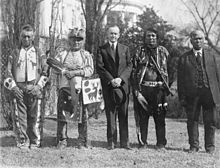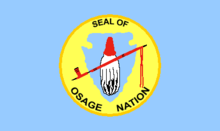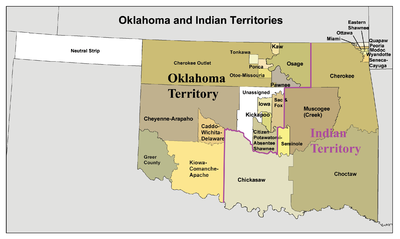Osage Nation
![]()
The title of this article is ambiguous. For other meanings, see Osage (disambiguation).
The Osage ([ˈoʊseɪdʒ] or [oʊˈseɪdʒ]) are a North American Indian tribe from the Dhegiha branch of the Sioux language family. The tribe is recognized by the United States of America as one of 33 Indian tribes in Oklahoma. The capital of the Osage Nation is located in Pawhuska, Oklahoma. The tribe has legal sovereign rights throughout Osage County. The Osage themselves originally called themselves Ni-u-kon-ska (Áã ÂäØïäØ͘) ("People of the Middle Waters"), beginning in the late 17th century they referred to themselves as Wah-zha-zhe or Wa-sha-she (English transcription in each case). This means "people of the waters" and was the name of their original tribe dominant in their mythology and tribal history. Later, other linguistically and culturally related tribes joined the Wah-zha-zhe and evolved into the Osage.
The tribal name in common use today as Osage developed through the adaptation of the spelling and pronunciation of the name Wa-sha-she by the French settlers and the British. The French wrote the first syllable Oua and the whole name as Ouasage. The British and Americans, in turn, wrote Osage. They pronounced the name much changed: the first syllable without [a] and the second syllable with the diphthong [eɪ] followed by the consonant [dʒ].

U.S. President Calvin Coolidge with four Osage Indians after signing the Indian Citizenship Act (1924).

Flag of the Osage Nation

Oklahoma around 1890
Residential area and history
Like the other members of this subgroup (Omaha, Ponca, Kansa, and Quapaw), the Osage migrated westward from the Atlantic coast, having previously lived on the Piedmont Plateau between the James and Savannah Rivers in Virginia, North, and South Carolina. Later they moved down the Ohio River, across the Mississippi River to the Ozark Plateau and onto the prairies of what is now western Missouri. At this point the five tribes separated; the Osage remained in villages on the Osage River, where they lived in 1673, according to Jacques Marquette. By 1802, according to Lewis and Clark, they lived on the Osage River, upstream on the Little Osage River, and on the Vermilion River, a tributary of the Arkansas River. The extent of their tribal territory was vast, covering large portions of four present-day states: Missouri, Kansas, Oklahoma, and Arkansas. The area was about 200,000 km², which is more than half the area of Germany (about 350,000 km²). The Osage called their land 'the center of the earth' because of its central location and fertility, and saw themselves as preservers of this land in the name of Wa-kon-ta-ke (The Mysterious Being of the Universe). The tribe numbered 5,500 at this time. They lived there until the early 19th century, when they ceded their lands in Missouri to the United States and moved west to the Neosho River Valley in Kansas. Here the Osage became known for their rejection of white culture; they continued to dress in animal skins and reportedly refused to drink alcohol.
After the end of the American Civil War (1861-1865), increasing pressure on the U.S. government to open all Indian land to white settlement led to the sale of the Kansas reservation. The proceeds were used to purchase land for the Osage in Indian Territory in 1870. The territory was bought from the Cherokee, who used the territory only for hunting. The area was called the Cherokee Outlet. The reservation land was divided among individual families in 1907 by the Osage Allotment Act. Each family was given 757 acres. This was significantly more land than usual (Between 40 and 160 acres). Typically, surplus land was raffled off or sold to non-tribal members under the Dawes Act. In the case of the Osage, surplus land was distributed to tribal members. The right to use mineral resources remained with the tribe. The Osage Mineral Estate was created for this purpose. The discovery of petroleum on the Osage Reservation in the late 19th century and an agreement with the United States government that all mining rights on the reservation would go to the tribe (lease money was distributed per capita) made the Osage a very wealthy Indian tribe by the early 20th century. Today they have about 20,000 tribal members. About 8,000 of them live on tribal land in northern Oklahoma, Osage County.
In the years between 1921 and 1926, hundreds of Osage were murdered. Their wealth had made them the target of criminal gangs trying to take lucrative land rights from them. The FBI took over the investigation and it became one of the young police department's first, major cases. In 1920, the tribe took $400 million in mining rights and distributed it to their tribal members. They were considered the richest people in the world. The tribe distributed $13,000 to each member in 1925. A family of 4 earned $52,000 a year as a result, the equivalent of $600,000 today. The U.S. Congress had to step in and changed the terms of the land grant. Only descendants of the tribe could be transferred land rights. This was an attempt to stop the killings. In 1999, the tribe began suing the Bureau of Indian Affairs for misappropriation of funds from mining rights. On October 14, 2011, a decision was handed down. The tribe was awarded $380 million in compensation from the United States Court of Federal Claims. The tribe had 16,000 members at the time.
Whether the reservation was dissolved by the U.S. Congress with the creation of the state of Oklahoma remains controversial. While President George W. Bush reaffirmed some of the tribe's ancient rights with the Osage Reaffirmation Act, the tribe lost a 2010 declaratory judgment case before the United States Court of Appeals for the Tenth Circuit. The lawsuit went down in the history books as Osage Nation v. Oklahoma. At issue in the trial was whether the reservation had been dissolved in 1907. The court upheld the dissolution by Congress. Specifically, the issue was whether an Osage who was employed by the tribe had to pay Oklahoma state taxes. Had the reservation not been dissolved, the employee would not have to pay taxes even though her property was not in trust. The court ruled that she must pay the taxes because the tax exemption only applies to Trust Land (tribal land) and not Fee Land (private land). So the reservation was dissolved in its boundaries by the Allotment (distribution of the land to the families of the tribe). On the other hand, the Bureau of Indian Affairs continues to recognize Osage County as tribal land. In 2020, the Tribe had a tribal land area of 135,000 acres (546 km²). The county has an area of 5967 km². The majority of residents are non-tribal members. It remains to be seen what the tribal government will do following the success of the neighboring Muskogee Indians in the United States Supreme Court. (See McGirt v. Oklahoma and Sharp v. Murphy). In 2011, an appeal of the judgment was not granted by the same court.
In 1997, a crisis occurred that nearly legally wiped out the entire tribe in Oklahoma. Since the dissolution of the tribal government Osage Nation Council in 1907, the business of the tribe was conducted by a tribal council Tribal Council. Unlike the tribal government, however, this had few sovereign powers. The owners of the land rights and their heirs were eligible to vote. These rights were called "headright." In some cases, before 1925, these rights had been passed on to non-tribal members or bequeathed to non-tribal organizations such as church congregations. If a "headright" was passed on to more than one heir it resulted in a splitting of the vote. It was incredibly difficult to determine an election result because there were 1/2, 1/4, 1/8, etc. Votes existed. In 1990, a tribal member who did not have a "headright" sued the tribe. The plaintiff claimed "one person one vote." The Tribe subsequently amended its constitution in 1994 and the Tribal Council was re-elected. The 1994 constitution, however, did not change the "headright" requirement for voting. The amendment only eliminated the splitting of votes. Even owners of a half or quarter "headright" now possessed a full vote in the election. But the original plaintiff, William S. Fletcher, along with 3 other Osage of the tribe who did not have a "headright," sued in federal court. The argument: under the 1994 constitution, only 4,000 of the then 17,000 tribal members were eligible to vote. This condition, and thus the tribe's constitution, would violate the United States Constitution. On June 10, 1997, the United States Court of Appeals for the Tenth Circuit ruled in Fletcher v. United States that the Act and the Tribe's constitution derived therefrom violated the United States Constitution. But this caused great irritation. Since the 1994 constitution was declared not to be legal, the list of tribal members that had been created under the Osage Allotment Act of 1906 was again applicable. After that, only 26 Osage would have been eligible to vote. The youngest voter would have been 90 years old. On March 11, 2006, a new constitution was adopted, with voting eligibility no longer based solely on the lists created under the Osage Allotment Act. This was made possible by the Osage Reaffirmation Act, signed by George W. Bush. The act declared that the tribe may adopt a constitution for itself that is not based on the Osage Allotment Act lists. Voting rights with the tribe and partial ownership of the Osage Mineral Estate were separated. But even that provision is causing acrimony. After the tribe received $380 million in compensation on Oct. 14, 2011, the question is who is entitled to receive those payments. Also in dispute is the revenue from the Osage Mineral Assets , as tribal members who do not own a "headright" will not receive payments from the tribe. The lawsuit is still pending in 2020.
According to the constitution of 2006, members of the Osage Nation can be persons and their descendants who were assigned a plot of land in 1906. Owning a "headright" is no longer a prerequisite. A blood percentage of at least 25%, as is common with other tribes, does not apply to the Osage. Only the owners of a "headright" are still entitled to vote in the election of the members of the Osage Minerals Council. The Osage Minerals Council distributes profits from the leasing of mining rights to those eligible to vote. Other tribal members may be eligible upon application. Conversely, this means that approximately 25% of the votes to elect the Osage Minerals Council continue to come from non-tribal members. And tribal members with a blood percentage of less than 25% continue to be considered Osage, even though the U.S. government actually requires a blood percentage of at least 25% to be considered Native American.
The ballet tradition founded by internationally renowned prima ballerinas Maria and Marjorie Tallchief continues to hold great importance at Osage.

The Osage Maria Tallchief
Culture
The Osage were culturally among the semi-settled Plains Indians with the characteristic combination of village farming and buffalo hunting. Other important hunting animals were deer, bear, and beaver. Their villages consisted of longhouses covered with mats and hides, built irregularly around an open space used for dances and council meetings. During the hunting season the Osage lived mostly in grass and shrub huts (called wickiups), and only when they went buffalo hunting on the Plains did they live in tepees. The Osage undertook three large tightly organized hunts each year - the buffalo hunt in the spring and fall, and the deer hunt (deer, antelope, beaver) in the winter. The center of Osage tribal life was religious ceremonies in which clans were divided into symbolic heaven and earth groups, the latter being again divided into dry land and water. The Osage were noted for their poetic rituals. It was their custom to recite the legend of the creation of the universe to each newborn child.
Questions and Answers
Q: What is the Osage tribe?
A: The Osage are a Midwestern Native American tribe of Plains Indians who historically ruled much of Arkansas, Missouri, Kansas, Oklahoma and Texas.
Q: Where did the Osage originally live?
A: The Osage originally lived among the Kansa, Ponca, Omaha, and Quapaw in the Ohio Valley.
Q: How did they migrate west?
A: They migrated west due to wars with the invading Iroquois.
Q: What language do they speak?
A: The Osage people refer to themselves in their own language as Wazhazhe.
Q: What was their lifestyle like?
A: The tribe controlled the area between the Missouri and Red River to the South and were greatly dependent on nomadic buffalo hunting and farming.
Q: How tall were members of this tribe typically?
A: George Catlin described them as being "the tallest race of men in North America" with most men at full growth being six feet or taller.
Q: Are they federally recognized today? A: Yes, the Osage are a federally recognized tribe today and have been based in Oklahoma since being forced to move there during 19th century.
Search within the encyclopedia